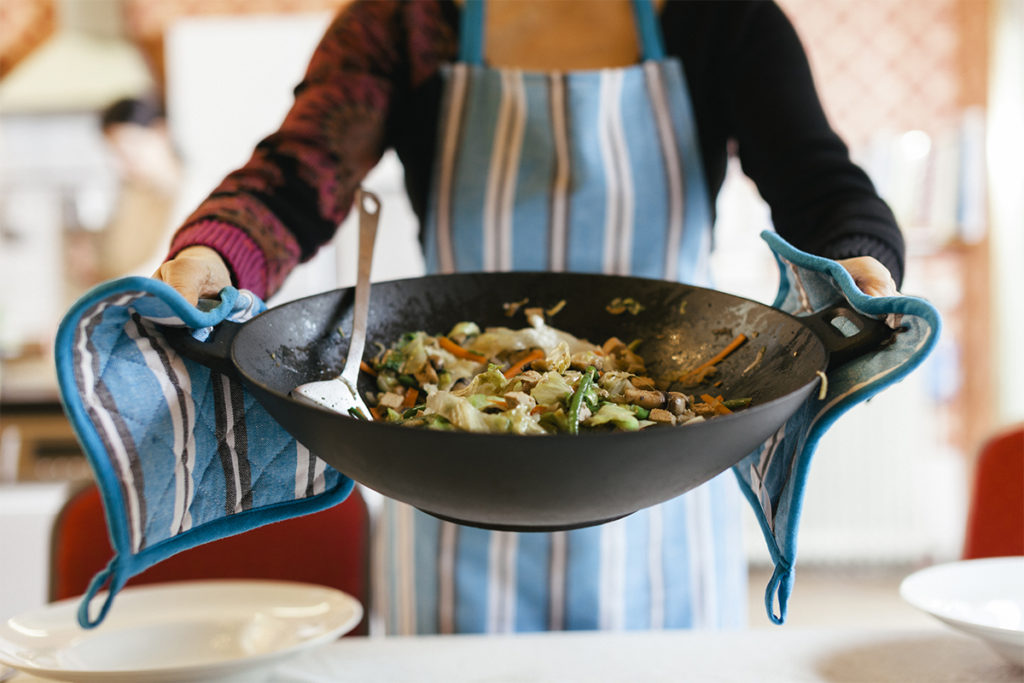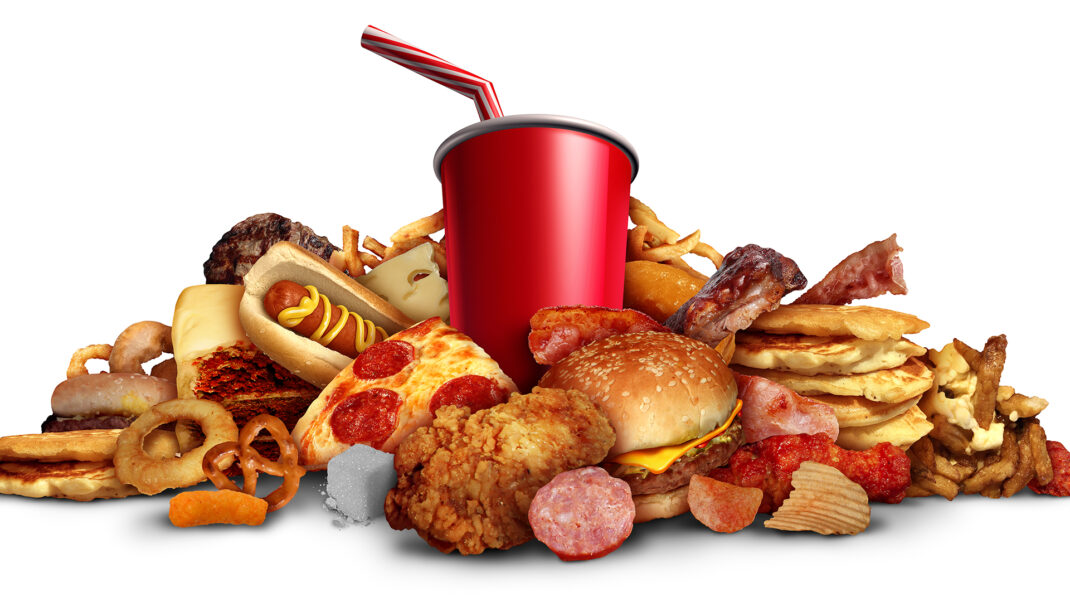How COVID-19 Has Changed Eating Habits
Here’s what researchers say has shifted—and how we can help clients transition to healthier habits, starting today.
|![]() Earn 1 CEC - Take Quiz
Earn 1 CEC - Take Quiz

If we could use one word to sum up our approach to eating habits once the pandemic was underway, it might be “improvisation.” To improvise is defined as “to make or fabricate out of what is conveniently on hand,” as in “to improvise a meal” (Merriam-Webster 2021). And that’s exactly what we did. We cooked out of the pantry, made concessions at the grocery store and shifted our mealtimes to suit upended schedules. We also watched our clients coping and adapting—sometimes thriving and other times facing struggles that continue to this day.
Though uncertainty remains, we can now begin to reclaim greater control of our nutrition, and the key to doing so is not improvisation but mindfulness and careful planning. That said, here’s a look at how eating habits have changed, what we can expect moving forward, and how we can support our clients and ourselves in health.
How Well Have We Done Overall?
Early in the pandemic, we were just coping—getting by from day to day. We all did our best to get through those very tough times, and for many that meant finding consolation in wearing comfy clothes and eating comfy foods as a means of self-care.
A 2021 American Psychological Association (APA) survey called Stress in America™ showed that, a year into the pandemic, about half of Americans felt concerned about the future. Numbers were higher among Black and Indigenous populations and People of Color (BIPOC), reflecting the uneven impact of COVID-19. In fact, 57% of Black, 51% of Asian and 50% of Hispanic respondents felt this way, while less than half of white Americans did (47%). Among parents, almost half said their stress level had risen since before the pandemic.
Krystal Register, MS, RDN, LDN, director of health and well-being at FMI (The Food Industry Association), saw the spike in stress firsthand: “Americans experienced phases of unhealthy eating early in the pandemic, driven by disrupted schedules, disrupted routines and habits, uncertainty of items on grocery store shelves, and an increased need for comfort foods due to high levels of stress and anxiety.”
Not surprisingly, many Americans subsequently watched the numbers on their bathroom scales fluctuate. In the 2021 APA survey, 61% of adults reported undesired weight changes during the pandemic. Forty-two percent reported undesired weight gain, with an average increase of 29 pounds. Among parents and essential workers, the average gain was higher—36 and 38 pounds, respectively. Sandra Arévalo, MPH, RDN, CDN, CLC, FADA, director of community and patient education at Montefiore Nyack Hospital in Nyack, New York, says many of her patients complained of “COVID pounds.” Other adults—about 18%—reported undesired weight loss, with an average decrease of 26 pounds (APA 2021).
Even as many Americans struggled, some took the opportunity of being at home to make positive lifestyle changes. One survey reported that 36% of respondents increased healthy eating behaviors and 33% increased physical activity (Zhang et al. 2021). Lisa Young, PhD, RDN, adjunct professor of nutrition at New York University, says some of her clients used their extra time at home to exercise, while others were couch potatoes. When working with the latter, she says, “I emphasized the importance of movement to feel better and be healthier, not just for weight loss.” This message carried over into some people’s eating and nutrition habits, as well.
An FMI survey reports that 49% of grocery shoppers are putting more or somewhat more effort into choosing healthy options because of the pandemic (FMI 2021a). The survey also notes that we have expanded our healthier approaches to eating, with more people saying they follow a Mediterranean diet or a whole-foods diet. Fewer people report following low-carb and keto diets.
Recognizing that clients have sometimes coped with pandemic stress in less-than-healthful ways is important—as is helping them reframe their goals for now and the future. Those who unintentionally gained or lost weight need support returning to healthful eating and exercise patterns. Acknowledging those who made positive progress is vital, too, as is recognizing that some have had ups and downs in these regards—and many still do. Reassessing all clients to understand how they have coped and where they are now is an important first step in creating a plan to move forward in health.
What Has Happened to Our Eating Habits?

Sharing meals can increase fruit and vegetable consumption and improve family connectedness.
We know that during the first COVID-19 wave in spring 2020, overall eating patterns remained pretty much the same as they were a year earlier. Although intermittent fasting began trending, most people continued to eat about four times a day: usually three meals and a snack (Hartman 2020). However, there was a significant increase in eating out of boredom, especially for those in Gen Z (adults ages 18–24).
This last point has been borne out anecdotally: Young notes that eating mindfully or only when hungry was especially challenging for her clients, and Arévalo says boredom from being at home led many people to struggle with portion control and to use food as a reward.
Overconsumption tendencies, along with a need for comfort, drove alcohol consumption higher in the U.S. as the pandemic persisted (see “During COVID-19, It’s 5 p.m.—Everywhere,” below). And as for food choices, 25% of Americans are buying indulgent or unhealthy foods or drinks more often now than they did before COVID-19, according to an FMI survey (FMI 2021a).
On a more positive note, perhaps: In spring 2020, while people were quarantining with families and roommates, they ate alone less often (43% versus 48% a year before). Half of snacking still took place alone, but that was down from 56% before the pandemic. And, not surprisingly—with many businesses closed—more snacking happened at home (88%) than in 2019 (78%) (Hartman 2020).
Register says, “The pandemic has amplified our desires to connect to and through food.” Sixty-one percent of Americans surveyed by FMI said eating together as a family or household was very important or extremely important, a significant increase from before the pandemic (FMI 2021a). Register adds, “Families recognize that shared meals are a way to stay strong together, with proven benefits like increased fruit and vegetable consumption and improved family connectedness.”
It will be essential for clients to practice mindfulness to identify those behavior changes that they wish to retain (such as eating with friends and family) and those that they wish to change (such as using food as a reward). Compassionate coaching can help people examine their habits objectively and make a plan for the future.
See also: Family Meal Planning
Will Grocery Shopping Ever Be the Same?

Almost two-thirds of us have shopped for food online since the pandemic began.
During the lockdowns, uncertainty became the norm, and our usual shopping habits turned upside down. Some of us are still probably working through all the toilet paper and flour we cleared off supermarket shelves. Register says online grocery shopping increased early in the pandemic out of necessity, to ensure everyone’s health and safety. But online grocery shopping is still going strong.
Before the pandemic, only about half of American adults surveyed had shopped for groceries online, and shoppers were reluctant to use online systems to buy fresh food like fruits, vegetables, meats and prepared foods. Now, almost two-thirds of us have shopped for food online, and the FMI survey reports that 34% of us are doing more of this than before, including buying fresh products (FMI 2021a). This is also true for people using the Supplemental Nutrition Assistance Program, which provides low-income Americans with assistance to purchase food. SNAP increased its benefits after COVID-19 began to spread, and grocery stores developed better SNAP online ordering and payment systems accordingly (FMI 2021b; USDA 2021).
“Grocery stores continue to increase their online capability and improve customer experience,” says Register. “Consumers are now used to shopping for groceries online, as well as using delivery and curbside pickup, and we expect these trends to continue.”
Register adds that, during the pandemic, dietitians who work for grocery stores have been adapting strategies to support changes in shopping, cooking and eating habits. They have worked on website updates, digital messaging, virtual cooking classes, telenutrition sessions, Instagram videos and YouTube lessons. She says, “We’re seeing food retail innovations around health and well-being that we expect to continue into the future.”
Farmers, too, have changed the way they do business. Michelle Wyler, managing director of Farm to Market with the Community Alliance with Family Farmers in Davis, California, reports that farmers increased their direct sales to consumers as wholesale and restaurant sales declined during shutdowns. Farms saw an increase in sales of food boxes and Community Supported Agriculture subscriptions, in which consumers get a weekly supply of fresh produce based on whatever is in season on the farm. Some farmers also offer eggs, meats, nuts and/or prepared products like jams.
Like grocery stores, small farmers have used online innovation to help consumers access food more easily during the pandemic. “We saw huge pivots from direct, in-person marketing by small farmers to online storefronts and ecommerce,” says Wyler.
What are some of the challenges these shopping trends might pose for clients? A CSA delivery creates a sort of Iron Chef situation for home cooks: What do you do with that large daikon or a bag of fingerling potatoes? On the flip side, fresh food boxes are a great way for people to increase their produce consumption and develop more creativity in the kitchen. For prepared foods, online shopping may stymie label reading (you can’t physically hold two items side by side for comparison), or it may do the reverse: Those with vision challenges can click on label images and upsize them on the computer screen. Again, clever coaching—and experimenting with these shopping options yourself—may help you set clients up for success.
See also: Nutrition and Cooking Strategies for Sheltering in Place
Is Eating In the New Eating Out?
COVID-19 hit restaurants hard. We have all missed being able to drop into our favorite places for a quick lunch or a date night. The National Restaurant Association reported that 40% of restaurants closed early in the pandemic, and we have yet to see how many will reopen and in what form. However, innovation in the restaurant industry has been extraordinary.
Restaurants and customers have adapted to low-contact and contactless eating. Takeout and delivery became the gold standard early in the pandemic, and online ordering soon followed. Those trends continue. Many restaurants reduced the number of items on menus to streamline production as they worked with a smaller staff. Some local restaurants got creative with prepared-meal subscriptions and with meal kits that customers would finish preparing at home. This helped eateries compete with services like Hello Fresh and Blue Apron.
What are we ordering? The National Restaurant Association says comfort food is still popular (think pizza, pasta and Mexican food), but so are healthy and diet-specific foods, including vegan and gluten-free items. Not surprisingly, burgers—still an American staple—remain top sellers across restaurant types (National Restaurant Association 2021).
The pandemic has also led to big pent-up demand for in-person dining experiences, with the industry trying hard to maintain staffing levels and customer service. Regardless of which way your clients choose to partake of prepared fare, they will no doubt need continued coaching, as dining out thoughtfully while keeping health top of mind can pose a challenge for many.
What’s Cooking in Your Kitchen?

70% of Americans report they have improved their cooking skills since the pandemic began.
How many loaves of sourdough did you make in the spring of 2020? Have you mastered the sheet pan meal? Trends came and went, especially on social media, but one positive and (so far) lasting change has been the increase in cooking at home. The FMI survey found that 58% of consumers are eating at home more and 49% are cooking meals more frequently, compared with pre-pandemic times (FMI 2021a).
Arévalo says this is one of the silver linings to come from COVID-19. “When you make your meals at home, you know what’s in your food.” The fare also tends to be healthier. Research shows that eating home-cooked meals more often is associated with better diet quality, including greater consumption of fruits and vegetables and lower sodium intake. In fact, the current Dietary Guidelines for Americans recognize that only a small proportion of our sodium intake comes from salt added in home cooking.
This shift to home cooking has changed the conversation around nutrition and wellness for BIPOC communities, adds Arévalo. “People who lost jobs needed to watch their budget and be able to prepare inexpensive meals.”
Affordability of food is increasingly important for consumers in general (Pollock Communications 2021). Arévalo notes, “People have come to realize how much money you save by cooking at home.”
Register points out that cooking also gives people “a sense of discovery and exploration,” which has been much needed during lockdowns. When you use interesting and unfamiliar ingredients and flavors, cooking can be like going to another country in your own kitchen.
As the pandemic continues, Datassential, which tracks food industry trends, predicts American regional foods and cuisines will be increasingly important in restaurant foods and in our collective consciousness (think Sonoran, Appalachian, Gullah and indigenous cuisines from around the country). This reflects our desire for connections to food, place, region, community and each other (Datassential 2021).
What is astounding—and supports the continuation of the home-cooking trend—is that 70% of Americans report they have improved their cooking skills since the pandemic began (FMI 2021a). “Consumers renewed their focus on healthy eating and developed new strategies for cooking healthy foods,” says Register. “Cooking healthy meals is the most improved cooking skill during the past year, a shift reflected in improved abilities to prepare fresh foods like produce, meat and poultry, and seafood. Looking ahead, we expect consumers to continue to cook at home.”
More positive trends that began with the pandemic:
- 34% of people do more meal planning in advance, which can ensure well-balanced meals that include plenty of fruits and vegetables.
- 25% rely more on frozen foods, which is a good thing if they include frozen fruits and vegetables, which are just as nutritious as fresh and often more convenient. It’s not so great if they include high-sodium processed foods.
- 25% read product labels more often, which is a great way to be sure products include nutritious ingredients and don’t have excessive amounts of salt or saturated fat (FMI 2021b).
Sharing your personal favorite recipes and techniques with clients can be a great way to strengthen your bond and improve their health. Nutritionists interviewed for this article suggest doing “batch cooking,” to save time and money when cooking at home, and using air fryers to make crispy, crunchy foods without deep frying.
How Will Food Be a Force for Change?
The murder of George Floyd, the Black Lives Matter movement, and flooding and wildfires across the world are just some ways the last 21 months have illuminated existing societal problems. We’ve been confronting these difficulties, in part, through our eating habits (Hartman 2021a). Americans are expressing a need for connection and community, while extending support to the most vulnerable in the pandemic, from farm workers to restaurant industry employees to those working in BIPOC-owned and community-minded businesses. We have expressed this support in many ways, including by buying from local farms and restaurants.
A Pew Research Center report released in May found that to help protect the environment from climate change, 81% of Americans say they are reducing food waste and 40% say they’re eating less meat (Tyson, Kennedy & Funk 2021). During the pandemic, 34% are avoiding food waste more than they were—something that’s easier to do as we cook and eat at home (FMI 2021a).
Even before the pandemic, plant-based eating was trending. Americans see it not only as a way to improve personal health but also as a way to reduce the impact of climate change. In 2021, nearly half of consumers are seeking plant-based foods, and 20% of Americans are eating more whole grains than they did before March 2020 (Hartman 2021b; Oldways Whole Grain Council 2021).
Eating to prevent food waste and lessen climate impact may also affect personal risk from COVID-19. Preliminary research shows an association between high diet quality, specifically healthy plant-based foods, and lower risk and severity of COVID-19 (Merino et al. 2021).
Understanding each client’s values may help you better coach your clients toward healthier choices that can be as good for the planet and humanity at large as they will be for them.
See also: How the Pandemic Redefined Customer Service
The Bottom Line: Supporting Clients in Better Eating Habits

Support your clients in doing more home cooking.
The improvisation of nutrition and eating habits during COVID-19 continues. Supportive professionals can be vital for helping clients drop negative behaviors, guiding transitions and cheering on practices that are going well. Here are some specific ways to help your clients thrive during this time:
- Acknowledge how hard the pandemic months have been on everyone. We don’t need to dwell on what we did or didn’t do; we can only do things differently going forward.
- Educate clients on ways food and drink are connected to health. Provide referrals if your clients have disordered behaviors around eating or alcohol use.
- Encourage self-care through healthy eating and exercise habits. Help clients see the link between eating and exercise habits and short-term benefits to mood.
- Cheer clients on to do more home cooking. Meals we prepare at home can be healthier, and cooking with friends and family can provide much-needed connection.
- Inspire values-driven eating that supports connections to family, friends, the community and the health of the planet.
Resources and Teaching Tools
The Gaples Institute: A physician-led educational nonprofit
- Healthy plate, healthy planet: An interactive guide to healthy, sustainable eating (gaplesinstitute.org/sustainable-diets/)
- Healthy plate, healthy planet handout (gaplesinstitute.org/sustainable
_diets/story_content/external_files/HealthyPlate-HealthyPlanet-PatientHandout.pdf)
The National Institute on Alcohol Abuse and Alcoholism
- Rethinking drinking: Alcohol and your health (rethinkingdrinking.niaaa.nih.gov/)
- NIAAA Alcohol Treatment Navigator (alcoholtreatment.niaaa.nih.gov)
Produce for Better Health Foundation
- Join the “have a plant” movement (fruitsandveggies.org/join-the-movement/)
U.S. Department of Agriculture
- Local food directories: Community Supported Agriculture (CSA) Directory (https://www.ams.usda.gov/local-food-directories/csas)
A Better Way to “Market” Produce to Clients
Are we eating more fruits and vegetables than we did before the pandemic? It’s too early to tell. Overall frequency of fruit and vegetable consumption has fallen nearly 10% since 2004 and 3% since 2015, says Wendy Reinhardt Kapsak, MS, RDN, president and CEO of the Produce for Better Health Foundation, which tracks this information in the United States. But the data isn’t in yet on whether we started eating more in the past 2 years.
How do we encourage clients to eat more fruits and vegetables? “We know from behavioral science,” Kapsak says, “that if we want people to do something, it has to be easy. Eating produce needs to be a repeated routine, so it becomes a lifelong habit. We have to stop telling people they need to eat produce for their physical health. They know this! What if we said, ‘It will make you feel good, maybe even happy, right now?’”
She points out that eating fruits and vegetables is actually associated with better mood: “People who say they eat more fruits and vegetables also report a greater sense of overall satisfaction with life.” She adds, “My advice for fellow fitness professionals is to talk more about good feelings associated with eating more fruits and veggies.”
Selling Nutrition as Self-Care and Health Care
“We’re seeing an evolution of self-care due to the pandemic,” says Janet Helm, MS, RDN, chief food and nutrition strategist at Weber Shandwick, a firm specializing in food trends. According to Helm, “People are taking a more proactive approach to health. Supporting immunity during COVID-19 is at the top of the list, and people are also looking to food and beverages to help them sleep and reduce stress and anxiety.”
She says gut health has been trending for a while, but “now there’s an even greater awareness of the important role the microbiome has on our overall health, especially as it relates to immunity. This has sparked innovation of new products that tout benefits to digestive health and immunity, such as prebiotic sodas, mushroom tea and coffee, probiotics in nondairy foods (such as peanut butter, nutrition bars and instant oatmeal), adaptogenic powders, and superfruit juices.”
During COVID-19, It’s 5 p.m.—Everywhere
Perhaps the most disturbing trend has been our increasing consumption of alcohol. Remember all those memes about day drinking while working from home? Turns out they were accurate. It has been serious enough that hospitalizations for alcoholic liver disease have gone way up since early 2020 (Cahan 2021).
Health economist Carolina Barbosa, PhD, and colleagues at the nonprofit research institute RTI International surveyed American drinking habits before and during lockdown and again as restrictions eased. The survey showed that Americans were drinking more on average during the pandemic than beforehand. They were also exceeding alcohol consumption guidelines more and binge-drinking more. Barbosa says the largest increases in consumption were in Black and Hispanic women, Black men, “men of other races,” and women with children under the age of 5. People with mental health issues also reported increases in drinking as a coping mechanism.
Why are people consuming so much alcohol? “COVID-19 restrictions had an impact on the psychological well-being of all, especially those most susceptible to negative effects of decreased social interactions and disruptions to work, school and leisure activities. People often increase alcohol intake to cope with emotional stress and chronic uncertainty,” says Barbosa. “Women are more likely to use alcohol to cope. This might explain the larger increase for women compared with men. In addition, women carry most of the responsibility for child care, and this might explain the increase in consumption for people with kids, and in particular, women with young kids. The increase in drinking among Black Americans can be explained by the well-documented disproportionate impact of the pandemic on racial and ethnic minorities and by other factors, such as distress from ongoing racial injustice.”
The American Psychological Association, in its Stress in America™ report, also noted increases in alcohol consumption, with nearly 1 in 4 Americans saying they began drinking more during the pandemic to cope with stress (APA 2021). The irony is that, while alcohol can temporarily relieve stress, in the long run it can contribute to anxiety and depression (Pollard, Tucker & Green 2020).
Unfortunately, Barbosa’s research shows that consumption hasn’t decreased as COVID-19 restrictions have eased. When asked how we can support clients and friends who are drinking more, Barbosa replied, “If people are drinking more because they are lonely or stressed, then a clear first step is to recognize the cause, and then find other, more healthy ways to handle that loneliness or stress. Reach out to a friend or family, if possible. Some may need to seek professional help either for their mental health or for the use of alcohol or other substances.”
Current guidelines on alcohol consumption from the 2020–2025 Dietary Guidelines for Americans are no more than two drinks per day for men or one drink per day for women (USDA 2020). We all need to be aware of the consequences of drinking more than recommended. Health risks include liver disease; cardiovascular disease; some types of cancers, including cancers of the mouth, throat, colon and liver; depression; and increased risk for postmenopausal breast cancer (NIAAA 2021).
For those who are interested in cutting back their consumption but not cutting alcohol out, there is a concurrent trend of new drinks that may help. Janet Helm, MS, RDN, chief food and nutrition strategist at Weber Shandwick, a firm specializing in food trends, notes that zero-proof spirits, creative no-alcohol “mocktails,” and low- and no-alcohol beers are more widely available and more popular than ever (Bandy 2021; Eads 2021). Let’s raise a nonalcoholic glass to that!
References
APA (American Psychological Association). 2021. Stress in America™. Accessed Aug. 23, 2021: apa.org/news/press/releases/stress/2021/sia-pandemic-report.pdf.
Bandy, J. 2021. Beverage trends of 2021: Non-alcoholic drinks. Goliath Consulting Group. goliathconsulting.blog/2021/01/11/beverage-trends-of-2021-non-alcoholic-drinks/.
Cahan, E. 2021. Pandemic-fueled alcohol abuse creates wave of hospitalizations for liver disease. Accessed Aug. 25, 2021: khn.org/news/article/pandemic-fueled-alcohol-abuse-creates-wave-of-hospitalizations-for-liver-disease/.
Datassential. 2021. Trends to know in 2021. FoodBytes: Trendspotting, 84, 10–11.
Eads, L. 2021. The brands and trends shaping the low- and no-alcohol category. thedrinksbusiness.com/2021/03/the-brands-and-trends-shaping-the-low-and-no-alcohol-category/.
FMI (The Food Industry Association). 2021a. The Power of Health and Well-Being in the Food Industry. Arlington, VA: FMI.
FMI. 2021b. U.S. Grocery Shopper Trends 2021. Arlington, VA: FMI.
Hartman Group. 2020. COVID-19’s Impact on Eating: Key Insights From The Hartman Group’s Eating Occasions Compass. Accessed Sep. 3, 2021: hartman-group.com/documents/888213358/covid-19s-impact-on-eating.
Hartman Group. 2021a. Accelerated, altered or accentuated: Five food and beverage trends driven by the pandemic—part one. Accessed Aug. 25, 2021: hartman-group.com/newsletters/1672953172/accelerated-altered-or-accentuated-five-food-and-beverage-trends-driven-by-the-pandemic-part-one?tm_campaign=Snacking+for+Distraction&tm_keyword=c-1x-d7ovq3yzl6cdu1phim42lao-2az0b40v1lezy6-tu1skb.
Hartman Group. 2021b. Plant-based eating trends: Label scrutiny. Accessed Aug. 25, 2021: hartman-group.com/infographics/2137711995/plant-based-eating-trends-label-scrutiny.
Merino, J., et al. 2021. Diet quality and risk and severity of COVID-19: A prospective cohort study. Accessed Sep. 3, 2021: medrxiv.org/content/10.1101/2021.06.24.21259283v1.
Merriam-Webster. 2021. Dictionary: Improvise. Accessed Aug. 25, 2021: merriam-webster.com/dictionary/improvise.
NIAAA (National Institute on Alcohol Abuse and Alcoholism). 2021. What are the consequences? Accessed Aug. 25, 2021: rethinkingdrinking.niaaa.nih.gov/How-much-is-too-much/Whats-the-harm/What-Are-The-Consequences.aspx.
National Restaurant Association. 2021. 2021 restaurant trends. Accessed Aug. 25, 2021: restaurant.org/research/reports/foodtrends.
Oldways Whole Grains Council. 2021. 2021 Whole Grains Consumer Insights Survey. Accessed Aug. 25, 2021: wholegrainscouncil.org/sites/default/files/atoms/files/WGC-Survey2021_0721.pdf.
Pollard, M.S., Tucker, J.S., & Green, H.D. 2020. Changes in adult alcohol use and consequences during the COVID-19 pandemic in the US. JAMA Network Open, 3 (9), e2022942.
Pollock Communications. 2021. Pandemic plates: Nutrition experts reveal top consumer diet changes due to COVID-19. Accessed Aug. 25, 2021: lpollockpr.com/uncategorized/pandemic-plates-nutrition-experts-reveal-top-consumer-diet-changes-due-to-covid-19/.
Tyson, A., Kennedy, B., & Funk, C. 2021. 3. Local impact of climate change, environmental problems. Accessed Aug. 25, 2021: pewresearch.org/science/2021/05/26/local-impact-of-climate-change-environmental-problems/.
USDA (United States Department of Agriculture). 2020. Dietary Guidelines for Americans 2020–2025. Accessed Aug. 27, 2021: dietaryguidelines.gov/sites/default/files/2020-12/Dietary_Guidelines_for_Americans_2020-2025.pdf.
USDA. 2021. USDA increases emergency SNAP benefits for 25 million Americans; ensures COVID-19 relief reaches those struggling the most. Accessed Aug. 27, 2021: usda.gov/media/press-releases/2021/04/01/usda-increases-emergency-snap-benefits-25-million-americans-ensures.
Zhang, X., et al. 2021. Individual-level determinants of lifestyle behavior changes during COVID-19 lockdown in the United States: Results of an online survey. International Journal of Environmental Research and Public Health, 18 (8), 4364.
Sanna Delmonico, MS, RDS, CHES
"Sanna Delmonico, MS, RDN, CHE, is an associate professor at the Culinary Institute of America where she teaches food safety and nutrition. She previously led programming for the CIA Healthy Kids Collaborative and the CIA-Harvard Healthy Kitchens, Healthy Lives Continuing Medical Education Conference. Prior to joining the CIA, she was an instructor at Santa Rosa Junior College where she co-coordinated the dietetic technician program. Sanna develops delicious, seasonal recipes and writes about food and nutrition for publications, including IDEA Fitness Journal. She lives in Napa, California, and is a home winemaker."





